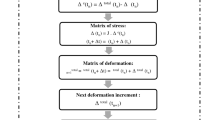Abstract
Composites reinforced with plant fibres show inelastic deformation under tensile loads. This property can be exploited in vibration-damping applications. Inelastic deformation was characterised for composites made from unsaturated polyester resin reinforced with unidirectional flax yarns. The primary yield point was found at a strain of 0.17%, with additional minor yielding events to a strain of 1.0% and then linear deformation to failure at a strain of 1.9%. Inelastic deformation accounted for approximately half of the total deformation across the final half of the stress–strain curve. Energy loss was greatest in the first load-unload cycle, with little change beyond the second cycle. The ratio of lost energy to stored energy settled to values between 0.23 and 0.40 for load-unload cycles peaking at between 15 and 75% of predicted maximum load. Failure stress remained unchanged after 2 × 104 load-unload cycles to approximately 50% of the breaking load. Results were consistent with kink bands straightening when fibres were first loaded, causing partial debonding at the fibre-matrix interface. Energy loss in subsequent cycles was attributed to friction between microfibrils within the kink bands as they twisted and untwisted.









Similar content being viewed by others
References
Hughes M, Carpenter J, Hill C (2007) J Mater Sci 42:2499. doi:10.1007/s10853-006-1027-2
Fereshteh-Saniee F, Majzoobi GH, Bahrami M (2005) J Mater Proc Technol 162–163:39
Barré S, Chotard T, Benzeggagh ML (1996) Compos A 27A:1169
Van Raemdonck J (2008) US Patent application 2008/0206537
Pickering KL, Bader MG, Kimber AC (1998) Compos A 29:435
Nechwatal A, Mieck K-P, Reussmann T (2003) Compos Sci Technol 63:1273
Christensen RM (2008) Acta Mech 196:239
Marklund E, Eitzenberger J, Varna J (2008) Compos Sci Technol 68:2156
Towo AN, Ansell MP (2008) Compos Sci Technol 68:915
Keckes J, Burgert I, Frühman K, Müller M, Kölln K, Hamilton M, Burghammer M, Roth SV, Stanzl-Tschegg S, Fratzl P (2003) Nat Mater 2:810
Kretschmann D (2003) Nature Mater 2:775
Fratzl P, Burgert I, Gupta HS (2004) Phys Chem Chem Phys 6:5575
Acknowledgements
The authors thank Peter Brorens and Henry Barker (AgResearch) for assistance in characterising fibres and making the composites, and the Biopolymer Network Limited for funding under New Zealand Foundation for Research Science and Technology contract BPLY0402.
Author information
Authors and Affiliations
Corresponding author
Rights and permissions
About this article
Cite this article
Newman, R.H., Battley, M.A., Carpenter, J.E.P. et al. Energy loss in a unidirectional flax-polyester composite subjected to multiple tensile load–unload cycles. J Mater Sci 47, 1164–1170 (2012). https://doi.org/10.1007/s10853-011-5713-3
Received:
Accepted:
Published:
Issue Date:
DOI: https://doi.org/10.1007/s10853-011-5713-3




